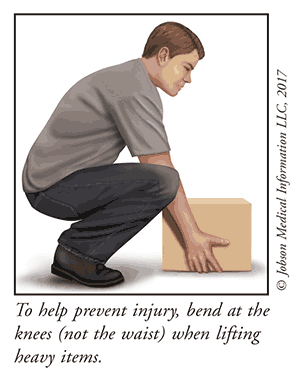US Pharm. 2017;41(3):11-12.
Discomfort That Lasts More Than 12 Weeks
Pain in the lower back that has been going on for 3 months or more is very common. Over 80% of Americans will experience some degree of lower back pain at least once in their lifetime. This statistic is not surprising since the spine is the physical center of the body and is involved in almost every movement a person makes. There are many opportunities for injury from misuse or overuse, even from routine activities. Undiagnosed and untreated chronic back pain can have a significant impact on the quality of an individual’s physical, social, and emotional well-being.
OTC and Prescription Pain Medications Can Provide Relief
About the Back
The back is made up of a system of bones, muscles, and nerves supported by the spinal column. The spine protects the spinal cord (the nerves that carry signals from the brain to the rest of the body), and it provides structure and stability for the upper body. Approximately 30 bones called vertebrae make up the spinal column. Spongy pads of cartilage commonly referred to as discs fit between each vertebra. These serve as “shock absorbers” for the spine and provide cushioning during movement.
What Causes Chronic Lower Back Pain?
There are several causes of lower back pain, but most cases are due to a mechanical injury—straining a muscle from lifting something that was too heavy. Other examples of mechanical injuries include a herniated or “bulging” disc caused by a car accident and arthritis caused by wear and tear of the spinal bones over time. When pain lasts more than 12 weeks, it is defined as chronic. While most injuries to the lower back heal completely, approximately 20% of the time the acute injury turns into a chronic pain condition that lasts for a year or more. An accurate diagnosis is important for ruling out other sources such as inflammation, fractures, infections, and cancer.

Symptoms and Diagnosis
Pain experienced with chronic lower back issues can range in intensity from a dull, general pain to a sharp, stabbing sensation that leaves the person unable to function. Men and women are equally impacted by lower back pain, but some lifestyle circumstances increase the risk, such as being overweight, limited exercise, too much sitting during the day, advancing age, and strenuous work conditions. To diagnose, physicians conduct a full physical examination and patient history, sometimes followed by x-rays, CT scan, MRI, or other medical tests.
Managing Chronic Lower Back Pain
As with many conditions, the best treatment is prevention. Lift heavy objects correctly or with the help of a second person. Add more movement to your day by getting up from your desk to move around every 60 to 90 minutes, or adopt a regular exercise routine. Do not go overboard with activity at first; take some time to build up strength and flexibility.
For someone dealing with chronic lower back pain, several treatment options are available. The first is short-term management of pain with OTC pain relievers such as acetaminophen (Tylenol), ibuprofen (Advil), and naproxen (Aleve). For chronic back pain, a physician might prescribe medications such as muscle relaxants, opioids or narcotics, and steroid injections to manage pain. Exercise extreme caution with prescription pain relief because of the increased risk of dependency and addiction. If patients experience pain that interferes with daily activities and work, they may be candidates for surgery as a last resort.
Many people have prevented and managed back pain with a combination of physical conditioning and manipulation. Chiropractors and physical therapists can help improve lower back function and reduce pain. Stretching, yoga, and core strengthening exercises can build strength and flexibility in the spine, further improving function and preventing additional damage.
Your local pharmacist is here to help. If you, a friend, or a family member has any questions about medications used to manage chronic lower back pain, ask a trusted pharmacist or other healthcare provider.





